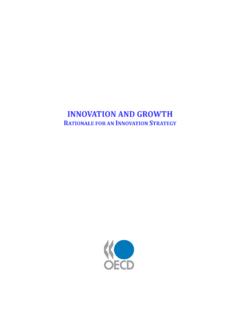Transcription of Key Findings - OECD
1 Ministerial report on theOECD innovation Strategy innovation to strengthen growth and address global and social challenges Key Findings May 2010 Introduction Current economic and social challenges are enormous .. Today, the world s societies face severe economic and social challenges. The 2008-09 economic downturn has led to reduced potential output growth, rising unemployment and soaring public debt. To recover, countries need to find new and sustainable sources of growth. The search for new sources of growth comes however at a time when many countries have stagnating or declining populations and face diminishing returns from labour inputs and investment in physical capital.
2 Future growth must therefore increasingly come from innovation -induced productivity growth. innovation the introduction of a new or significantly improved product, process or method (Box 1) holds the key to boosting productivity.. and often global in nature. Countries economic difficulties come at a time of increasing political pres-sure to meet various social challenges, many of which are global in nature (such as climate change) or require global action (health, food security, the growing scarcity of clean water).
3 Without a strong and co-ordinated policy response to such problems, the future looks bleak: global temperatures may increase by 4-6 C by the end of the century, the world will have to feed 3 billion more people by 2060, and 14-17 million people will continue to die every year from infectious diseases that could be cured or avoided. Such challenges cannot be dealt with single-handedly by any country and require a more co-ordinated effort by countries through supply-side and demand-side interventions.
4 innovation , and coherence in policy interventions, is necessary to address these and other problems in an affordable and timely manner. Box 1. Defining and measuring innovation There is growing recognition that innovation encompasses a wide range of activities in addition to R&D, such as organisational changes, training, testing, marketing and design. The latest (third) edition of the Oslo Manual defines innovation as the implementation of a new or significantly improved product (good or service), or process, a new marketing method, or a new organisational method in business practices, work-place organisation or external relations.
5 By definition, all innovation must contain a degree of novelty. The Oslo Manual distinguishes three types of novelty: an innovation can be new to the firm, new to the market or new to the world. The first concept covers the diffusion of an existing innovation to a firm the innovation may have already been implemented by other firms, but it is new to the firm. Innovations are new to the market when the firm is the first to introduce the innovation on its market. An innovation is new to the world when the firm is the first to introduce the innovation for all markets and industries.
6 innovation , thus defined, is clearly a much broader notion than R&D and is therefore influenced by a wide range of factors, some of which can be influenced by policy. innovation can occur in any sector of the economy, including government services such as health or education. However, the current measurement framework applies to business innovation , even though innovation is also important for the public sector. Consideration is being given to extending the methodology to public sector innovation and innovation for social goals.
7 Source: OECD and Eurostat (2005), Oslo Manual Guidelines for Collecting and Interpreting innovation Data, OECD, Paris. 2 OECD innovation Strategy innovation can help accelerate the recovery and put countries back on a path to sustainable and greener growth. innovation is thus essential if countries and firms are to recover from the economic downturn and thrive in today s highly competitive and connected global economy. It is a powerful engine for development and for addressing social and global challenges. And it holds the key, both in advanced and emerging economies, to employment generation and enhanced productivity growth through knowledge creation and its subsequent application and diffusion.
8 innovation policies are therefore of crucial importance for emerging from the crisis .. Yet the current economic environment raises a risk that governments will make policy and budgeting decisions that are not the best for the medium term and may harm innovation and longer-term prosperity. It is crucial to continue to invest in future long-term sources of growth, such as education, infrastructure and research. This must be a continuing priority as countries seek to move beyond the current crisis.
9 While cutting back public investment in support of innovation may provide short-term fiscal relief, it will hurt long-term growth. The focus on these areas in recent stimulus packages was welcome, but a continuing strong baseline of investment is essential if productivity benefits are to accrue and a return to growth is to be achieved. Moreover, innovation -driven growth makes it easier for governments to make the necessary investments and policy interventions to address the many global challenges facing society.
10 At the same time, there is much scope to improve the efficiency of government spending and to innovate in the delivery of public services.. even in countries with limited scope for public investment. Even countries with constrained public finances can do much to strengthen innovation . Governments establish the frameworks, regulations and mar-kets that enable firms and other actors to engage in innovation . Structural reforms in education and training policies, in entrepreneurship policies, in product and labour markets, in public research institutions, and in policies to help develop networks and markets for knowledge can go a long way towards improving the environment for innovation .
















